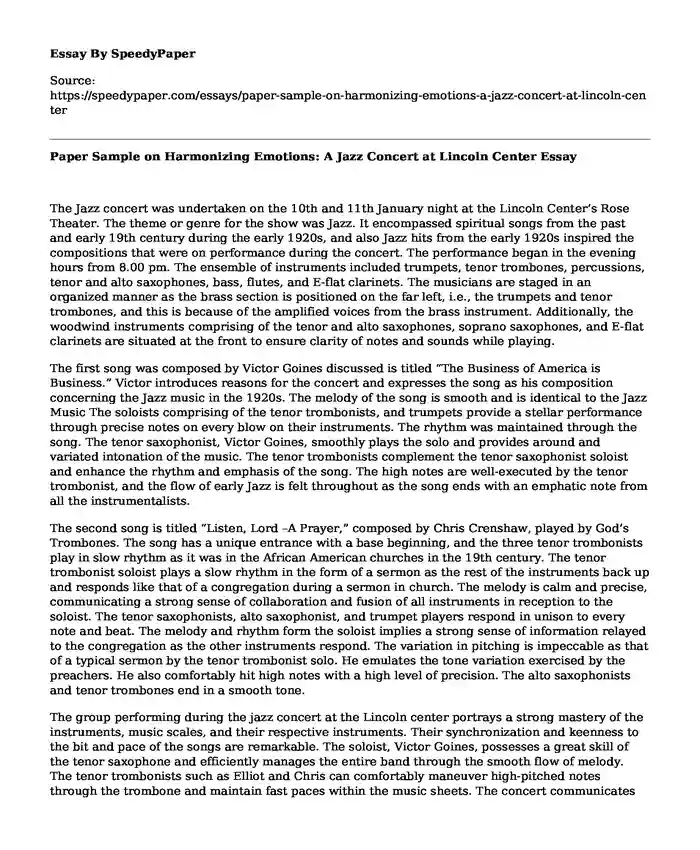
| Essay type: | Analytical essays |
| Categories: | Music Culture |
| Pages: | 3 |
| Wordcount: | 627 words |
The Jazz concert was undertaken on the 10th and 11th January night at the Lincoln Center’s Rose Theater. The theme or genre for the show was Jazz. It encompassed spiritual songs from the past and early 19th century during the early 1920s, and also Jazz hits from the early 1920s inspired the compositions that were on performance during the concert. The performance began in the evening hours from 8.00 pm. The ensemble of instruments included trumpets, tenor trombones, percussions, tenor and alto saxophones, bass, flutes, and E-flat clarinets. The musicians are staged in an organized manner as the brass section is positioned on the far left, i.e., the trumpets and tenor trombones, and this is because of the amplified voices from the brass instrument. Additionally, the woodwind instruments comprising of the tenor and alto saxophones, soprano saxophones, and E-flat clarinets are situated at the front to ensure clarity of notes and sounds while playing.
The first song was composed by Victor Goines discussed is titled “The Business of America is Business.” Victor introduces reasons for the concert and expresses the song as his composition concerning the Jazz music in the 1920s. The melody of the song is smooth and is identical to the Jazz Music The soloists comprising of the tenor trombonists, and trumpets provide a stellar performance through precise notes on every blow on their instruments. The rhythm was maintained through the song. The tenor saxophonist, Victor Goines, smoothly plays the solo and provides around and variated intonation of the music. The tenor trombonists complement the tenor saxophonist soloist and enhance the rhythm and emphasis of the song. The high notes are well-executed by the tenor trombonist, and the flow of early Jazz is felt throughout as the song ends with an emphatic note from all the instrumentalists.
The second song is titled “Listen, Lord –A Prayer,” composed by Chris Crenshaw, played by God’s Trombones. The song has a unique entrance with a base beginning, and the three tenor trombonists play in slow rhythm as it was in the African American churches in the 19th century. The tenor trombonist soloist plays a slow rhythm in the form of a sermon as the rest of the instruments back up and responds like that of a congregation during a sermon in church. The melody is calm and precise, communicating a strong sense of collaboration and fusion of all instruments in reception to the soloist. The tenor saxophonists, alto saxophonist, and trumpet players respond in unison to every note and beat. The melody and rhythm form the soloist implies a strong sense of information relayed to the congregation as the other instruments respond. The variation in pitching is impeccable as that of a typical sermon by the tenor trombonist solo. He emulates the tone variation exercised by the preachers. He also comfortably hit high notes with a high level of precision. The alto saxophonists and tenor trombones end in a smooth tone.
The group performing during the jazz concert at the Lincoln center portrays a strong mastery of the instruments, music scales, and their respective instruments. Their synchronization and keenness to the bit and pace of the songs are remarkable. The soloist, Victor Goines, possesses a great skill of the tenor saxophone and efficiently manages the entire band through the smooth flow of melody. The tenor trombonists such as Elliot and Chris can comfortably maneuver high-pitched notes through the trombone and maintain fast paces within the music sheets. The concert communicates the need for high-level precision and coordination in providing a blend of right music pieces through a combination of various scales. The songs as played induce the emotion implied by the player, and this is the power of music.
Cite this page
Paper Sample on Harmonizing Emotions: A Jazz Concert at Lincoln Center. (2023, Oct 12). Retrieved from https://speedypaper.com/essays/paper-sample-on-harmonizing-emotions-a-jazz-concert-at-lincoln-center
Request Removal
If you are the original author of this essay and no longer wish to have it published on the SpeedyPaper website, please click below to request its removal:
- All Of Me by Billie Holliday - Free Essay with the Song Analysis
- Free Essay Example on Organizational Culture Theories
- Free Essay Example on the Men's Fashion Industry
- Free Essay with Characterization of "Trifles" by Susan Glaspell
- Example of Compare and Contrast Essay on Chinese and American Cultures
- Free Essay Example - Wealth Gap in the US
- Essay Sample on Organizational Communication Strategies and Practices Application
Popular categories




